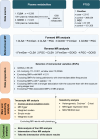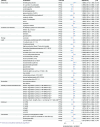Causal relationships between hundreds of plasma metabolites and PTSD: a bidirectional mendelian randomization study
- PMID: 40200279
- PMCID: PMC11980153
- DOI: 10.1186/s12888-025-06796-2
Causal relationships between hundreds of plasma metabolites and PTSD: a bidirectional mendelian randomization study
Abstract
Background: Recent studies have indicated a connection between plasma metabolites and Post-traumatic stress disorder (PTSD). Nevertheless, the precise causal relationship remains unclear.
Methods: We performed bidirectional Mendelian Randomization (MR) using two metabolite and two PTSD GWAS datasets to examine causal relationships between PTSD and 1009 plasma metabolites. Forward MR tested metabolite causally effects on PTSD, while reverse MR assessed PTSD causally effects on metabolites. Primary analysis employed the IVW method, supported by four supplementary methods. Four IVW results per direction were meta-analyzed to identify high-credibility metabolites. Venn diagrams intersected results from the four IVW analyses, and this intersection was further compared with meta-analysis findings to generate a second Venn diagram. Sensitivity analyses addressed horizontal pleiotropy for robust results.
Results: After sensitivity analyses, a robust set of 775 metabolites in the forward MR analysis and a set of 566 ones in the reverse process were identified. The meta-analysis of IVW method results (four results between two metabolites GWAS and two PTSD GWAS) revealed that 58 metabolites were significantly associated with the risk of PTSD (P < 0.05) in the forward MR analysis, and 19 metabolites might exhibit significant changes in PTSD (P < 0.05) in the reverse progress. Further Venn diagram intersection analysis among those four IVW results unveiled 4 metabolites with promoting or inhibiting effects on PTSD (P < 0.05) and 1 metabolites with notably increased plasma levels in PTSD (P < 0.05). The subsequent Venn diagram intersection analysis of the meta-analysis outcomes and the initial Venn diagram results identified 3 metabolites. In the forward analysis, 5-hydroxy-2-methylpyridine sulfate (OR = 1.05, P = 0.004) and levulinoylcarnitine (OR = 1.08, P = 0.005) from the Xenobiotics pathway were significantly associated with an increased risk of PTSD. Additionally, cysteinylglycine from the Amino Acid pathway significantly reduced the risk of PTSD (OR = 0.918, 95%CI: 0.868-0.971, P = 0.003). In the reverse analysis, no significant changes in plasma metabolites at the genetic level were found to causally influence the development of PTSD.
Conclusions: Our findings provide potential biomarkers for predicting and preventing PTSD, as well as possible therapeutic targets for that. However, further research is needed to confirm the clear mechanism.
Keywords: GWAS; Mendelian randomization; Meta-analysis; PTSD; Plasma metabolites.
© 2025. The Author(s).
Conflict of interest statement
Declarations. Ethics approval and consent to participate: Not applicable. Our analysis used publicly available genome-wide association study (GWAS) summary statistics. No new data were collected, and no new ethical approval was required. Consent for publication: Not applicable. Competing interests: The authors declare no competing interests.
Figures







Similar articles
-
Human blood metabolites and risk of post-traumatic stress disorder: A Mendelian randomization study.J Affect Disord. 2025 Mar 1;372:227-233. doi: 10.1016/j.jad.2024.12.029. Epub 2024 Dec 4. J Affect Disord. 2025. PMID: 39643216
-
Causal effects of plasma metabolites on chronic kidney diseases and renal function: a bidirectional Mendelian randomization study.Front Endocrinol (Lausanne). 2024 Jul 26;15:1429159. doi: 10.3389/fendo.2024.1429159. eCollection 2024. Front Endocrinol (Lausanne). 2024. PMID: 39129920 Free PMC article.
-
Causality of genetically determined metabolites on anxiety disorders: a two-sample Mendelian randomization study.J Transl Med. 2022 Oct 20;20(1):475. doi: 10.1186/s12967-022-03691-2. J Transl Med. 2022. PMID: 36266699 Free PMC article.
-
Causal association between plasma metabolites and diverse autoimmune diseases: a two-sample bidirectional mendelian randomization study.Front Immunol. 2024 Nov 7;15:1437688. doi: 10.3389/fimmu.2024.1437688. eCollection 2024. Front Immunol. 2024. PMID: 39575250 Free PMC article.
-
Childhood maltreatment and mental health: causal links to depression, anxiety, non-fatal self-harm, suicide attempts, and PTSD.Eur J Psychotraumatol. 2025 Dec;16(1):2480884. doi: 10.1080/20008066.2025.2480884. Epub 2025 May 14. Eur J Psychotraumatol. 2025. PMID: 40367030 Free PMC article.
References
Publication types
MeSH terms
Grants and funding
LinkOut - more resources
Full Text Sources
Medical

